Scientific name: Pyrus communis
Cultivars: ‘Harrow Delight’ and ‘Summercrisp’
Common names: ‘Harrow Delight’ pear and ‘Summercrisp’ pear
Scientific name: Pyrus calleryana
Common name: Callery pear
Cultivar: ‘Bradford’
Common name: ‘Bradford’ pear
Family: Rosaceae
Article by Jeanne Gozigian
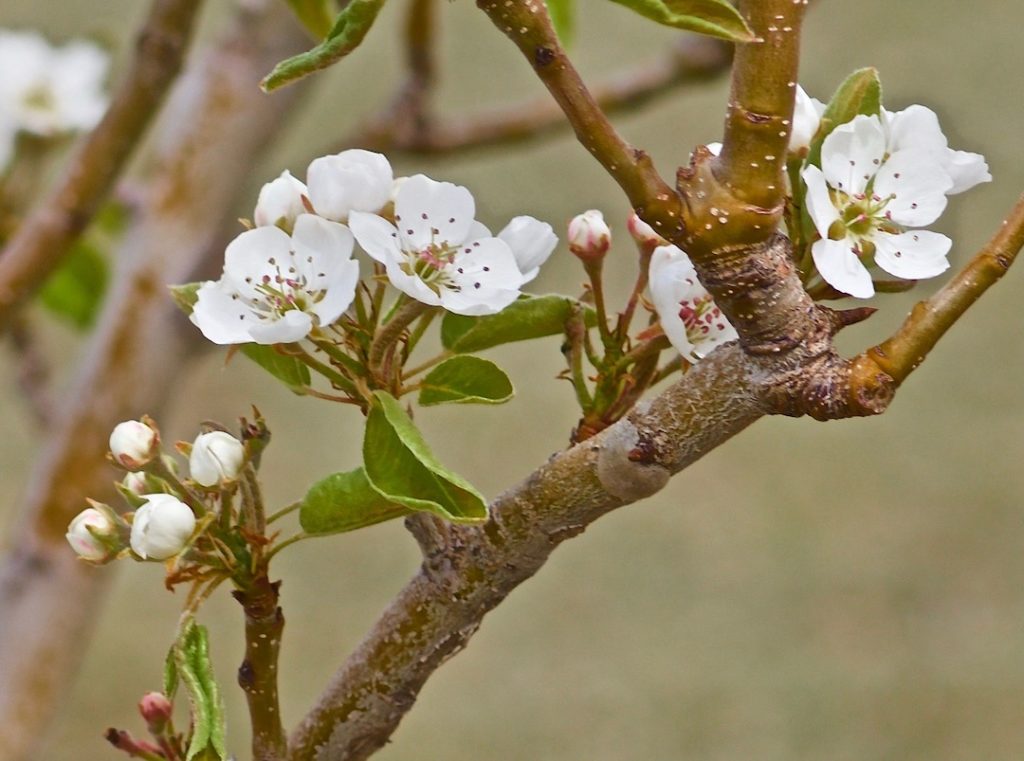
Pyrus communis ‘Harrow Delight’ pear flowers. Photo by Janice Tucker
The glory of spring is, in part, due to the flowering of fruit trees. We all know of the legendary cherry trees, a gift from Japan, that bloom at the National Mall in Washington, D.C.
In Santa Fe, New Mexico, at the Santa Fe Botanical Garden at Museum Hill, a similar rite of spring occurs with the blossoming of fruit trees in the Goede Family Orchard. Among other fruit -bearing trees like peach, apple, plum and cherry, the ‘Harrow Delight’ pear bursts forth in glory with creamy white, 5-petaled (Rose family!), fragrant, showy blossoms in corymbs. Another pear cultivar in the orchard is the ‘Summercrisp’.
‘Harrow Delight’ and ‘Summercrisp’ descend from the common European wild pear, Pyrus communis, native to central and eastern Europe and southwestern Asia. From this species, most of the orchard pear culitvars in Europe, North America and Australia have been developed. These include ‘Comice’, ‘Bartlett’ and ‘D’anjou’.
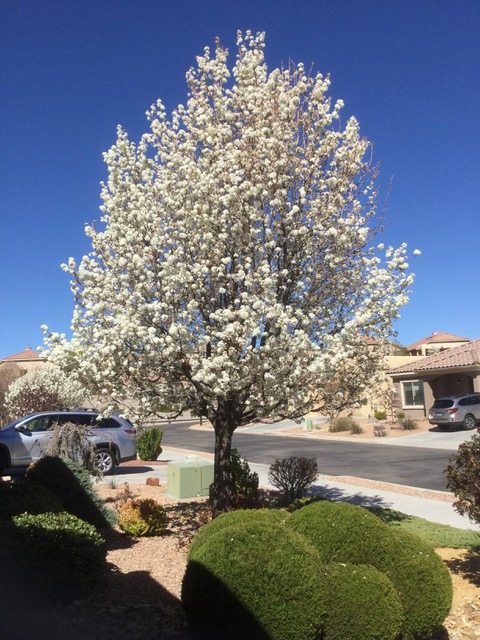
Pyrus calleryana ‘Bradford’ in spring flower. Photo by Jeanne Gozigian.
Pear trees have also been sought after and cultivated not only for fruit production, but also for their ornamental value and appeal in landscaping, including New Mexico. As the suburban landscape expanded, Pyrus calleryana, the Callery pear, was used to develop the cultivar ‘Bradford’, which was widely planted in North America, and escaped cultivation becoming naturalized in abandoned fields, fencerows and open woodland in the eastern United States. ‘Bradfords’ are typically 16-26 feet in height. They are very resistant to fire blight but their weaker wood makes them susceptible to storm damage. The plant profile is conical, ovate, with rounded crowns. When I look down the block in my neighborhood on the Rio Grande bosque near Albuquerque, NM, almost every house has a ‘Bradford’ pear in the front yard. My neighbor, Nancy, lost her ‘Bradford’ last year due to imprudent pruning, I think, then storm damage. All others soldier on to spring awakening.
The oval, glossy dark green leaves are 1.5-3.1 inches long with pale undersides. The 5-petaled flowers, 0.79-0.98 inches in diameter, which appear in white clusters before the leaves unfurl, have an unpleasant odor.
Pyrus calleryana are named for Italian- French sinologue (specialist in the study of Chinese and especially the language, literature and culture, according to Merriam-Webster), Joseph Marie Callery, a French missionary (1810-1862). He sent them to Europe from China, thinking that they would be a good addition to gardens. They have tiny, inedible fruits, allowing for a spring display without the mess of fruit fall and harvest. Frank N. Meyer, known for the discovery of the Meyer lemon, introduced them into the United States. However, the Meyer lemon has been a good addition to our fruit tree cultivation, unlike the Callery pear.
Good intentions in the selection of the ‘Bradford’ cultivar sought out attractive traits such as thornless bark, less messy fruiting, resistance to disease, and ability to grow in poor soils. If clones of this tree were always planted in isolation, the result would ideally be inability to self-pollinate and sterile fruit. However, this was an unrealistic scenario. Instead, of course other cultivars of Callery pears were developed, and even offshoots of ‘Bradford’ grew wild sprouts, ultimately leading to cross-pollination, genetic diversity, and thus fertile fruits. Futhermore, the small inedible fruits of P. calleryana, when softened by frost, proved to be attractive to birds. They gorged on them and dispersed the seeds in their droppings. It proved to be a disaster, and soon the ‘Bradford’ pear became invasive. I can attest to this, constantly pulling out seedlings that pop up under my ‘Bradford’. Somehow, these supposedly sterile seeds germinated. Or, perhaps, these are offshoots from the roots.
There are many authorities today, such as the Invasive Plant Atlas of the United States, that warn that the sterile ‘Bradford’ can hybridize with other pears, produce viable fruit and spread seeds in natural areas. It has been named a “Weed of the Week” by the USDA Forest Service.
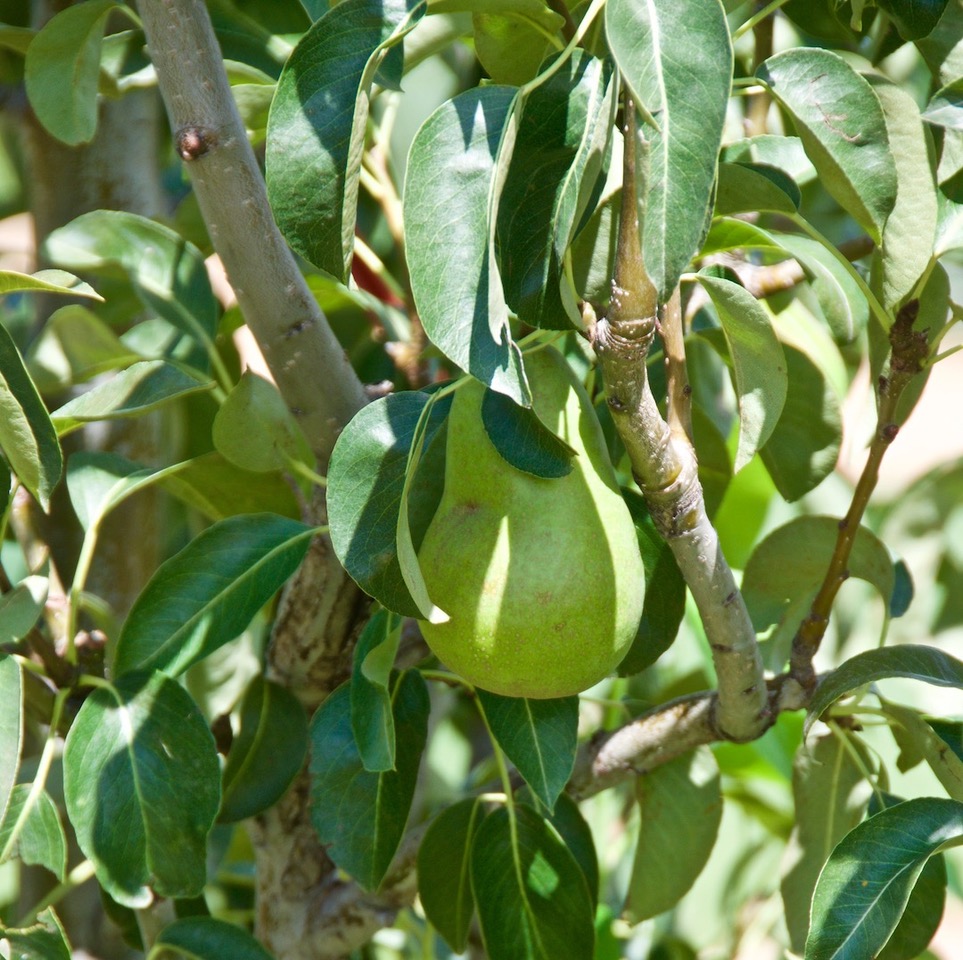
Pyrus communis ‘Harrow Delight’ fruit. Photo by Janice Tucker.
So, let us turn back to Pyrus communis cultivars that produce edible fruits, like ‘Harrow Delight’. It is a hybrid (‘Old Home’ × ‘Early Sweet’) × ‘Bartlett’. It is very resistant to blight and pear scab. The yellow fruits, blushed with red, have smooth flesh, without grit, and excellent flavor.
These trees are heavy bearing, the large harvest ripening between July 15 and August 1. It is best to wait to harvest after the third year from planting. The ‘Harrow Delight’ was introduced to the United States in 1982 from the Harrow Agricultural Station in Ontario, Canada.
The cultivation of pears first appears in the works of Greeks and Romans, e.g., the Romans, Cato the Elder and Pliny the Elder. They spoke of cultivating and grafting of pear trees to improve them. Pear trees, while not as hardy as apple trees, are close when planted in temperate zones 4-8. The Santa Fe Botanical Garden is in USDA zone 6b.
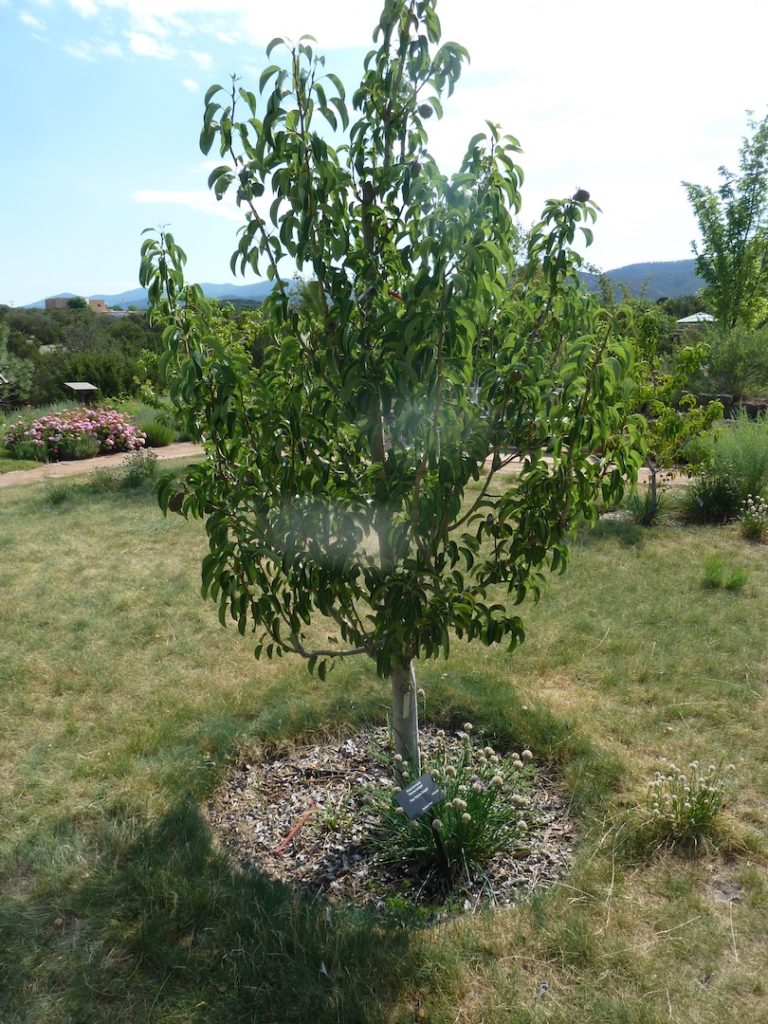
Pyrus communis ‘Harrow Delight’ young tree. Photo by Janice Tucker.
‘Harrow Delight’ pear trees reach 30-40 feet in height and 30-40 feet in width. The trees are oval in shape with upward reaching branches. If they are unpruned they will only reach 2/3 (12-18 feet) of standard height. This is the size of the semi-dwarf variety. Their simple green leaves have fine toothed margins. They should be planted in full sun in soils with good drainage, but are tolerant of heavy, wet soils. The clusters of fragrant white flowers attract butterflies and other Lepidoptera. They need 800 hours of chill November through February, in the temperature range of 32-45 degrees F, to produce. The trees may be espaliered.
‘Summercrisp’ pear trees are very cold hardy and early ripening. The pink and white blossoms yield greenish fruits with red blush, sweet and crisp to eat, in one to two years time. The trees were developed in 1933 by the University of Minnesota Fruit Breeding Farm. Full sun is required but almost any soil type will be tolerated. Branches with glossy green, oval shaped leaves do not need pruning. The plant profile is bushy; the 14- foot width practically equaling the 15-25 foot height.
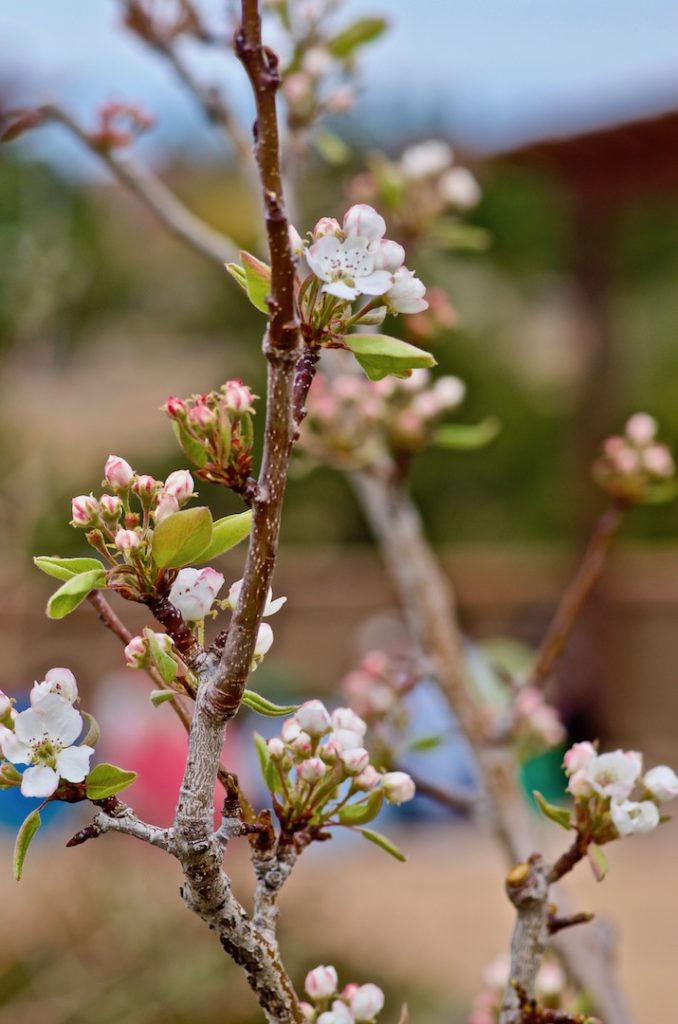
Pyrus communis ‘Summercrisp’ flowers and buds. Photo by Janice Tucker.
We need to be reminded of the importance of insects to pollination. Lepidopterans, are an order in the class of insects which include butterflies and moths, from the ancient Greek, “lepis”, meaning scale, and “ptreon”, meaning wing (Linnaeus-1758). All body parts are covered with scales, perhaps an adaption of feathers. Lepidopterans are necessary to pollination and are great pollinators, but in their larval (caterpillar) state can cause huge damage to crops. They can eat the leaves of pear trees. It is interesting that biologists hypothesize evolutionary transformation caused moths to be nocturnal and duller in color so that they could avoid being eaten by bats. Butterflies, in contrast, are brilliantly colored and are diurnal. Their brilliant colors may warn predators of their often toxicity. Bees, flies and birds, such as hummingbirds, are also pollinators. All are vital to agriculture around the world.
Most pears have bright autumn foliage, yellow, orange to red, which may be frozen off in cold climates before it can be displayed. P. communis supports fungi like artist’s conk, chicken of the woods and southern bracket. The fermented juice of pears is called, Perry. In the UK, the historic presence of the name, Perry, would indicate the presence of pear trees. Pear wood is the finest textured of all fruit woods, making it ideally suited for veneer for fine furniture, musical instruments and woodblock printing. I would hope that the loss of Nancy’s mature tree has led to some sweet music!
Thanks to Janice Tucker and Helen Woody for proofreading this article.
Sources:
“Callery pear/Bradford pear”. Weed of the Week. USDA Forest Service. Web. 20 Feb 2020. Retrieved from: https://www.invasive.org/weedcd/pdfs/wow/callery_pear.pdf
“Callery pear (Bradford pear)”. Missouri Department of Conservation. Web. 19 Feb 2020. Retrieved from: https://nature.mdc.mo.gov/discover-nature/field-guide/callery-pear-bradford-pear
“Dwarf Summercrisp Pear Tree”. The Home Depot. Web. 21 Mar 2020. Retrieved from: https://www.homedepot.com/p/Online-Orchards-Dwarf-Summercrisp-Pear-Tree-Cold-Hardy-Juicy-and-Crisp-Red-Pears-Bare-Root-3-ft-to-4-ft-Tall-2-Years-Old-FTPR004/310612742?
“lepidoptera”. Merriam-Webster.com. Merriam-Webster. 2020. Web. 11 Mar 2020. Retrieved from: https://www.merriam-webster.com/dictionary/lepidoptera
McGroarty, Kent Page. “About Summercrisp Pear Trees”. SFGATE. Web. 21 Mar 2020. Retrieved from: https://homeguides.sfgate.com/summercrisp-pear-trees-23158.html
“Pear”. tree-guide.com. Web. 21 Mar 2020. Retrieved from: https://www.tree-guide.com/pear
“Pyrus calleryana”. Wikipedia: The Free Encyclopedia. Wikimedia Foundation, Inc. 13 May 2020. Web. 21 Mar 2020. Retrieved from: https://en.wikipedia.org/wiki/Pyrus_calleryana
“Pyrus communis”. Wikipedia: The Free Encyclopedia. Wikimedia Foundation, Inc. 13 May 2020. Web. 3 Mar 2020. Retrieved from: https://en.wikipedia.org/wiki/Pyrus_communis
“Pyrus communis”. Plant Finder. Missouri Botanical Garden. Web. 3 Mar 2020. Retrieved from: http://www.missouribotanicalgarden.org/PlantFinder/PlantFinderDetails.aspx?kempercode=a897
“Pyrus communis ‘Harrow Delight'”. Garden Explorer. Santa Fe Botanical Garden. Web. 3 Mar 2020. Retrieved from: https://santafebotanicalgarden.gardenexplorer.org/taxon-591.aspx
“Pyrus communis ‘Harrow Delight'”. North Carolina Extension Gardener Plant Toolbox. N.C. Cooperative Extension. Web. 11 Mar 2020. Retrieved from: https://plants.ces.ncsu.edu/plants/pyrus-communis-harrow-delight/
“sinology”. Merriam-Webster.com. Merriam-Webster. 2020. Web. 20 Feb 2020. Retrieved from: https://www.merriam-webster.com/dictionary/sinology
“Harrow Delight Pear Tree, European Type (Semi-dwarf)”. groworganic.com. Peaceful Valley Farm Supply, Inc. Web. 12 Mar 2020. Retrieved from: https://www.groworganic.com/products/pear-harrow-delight-european-semi-dwarf


